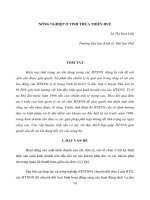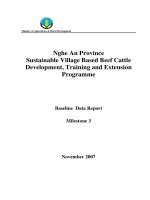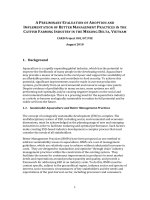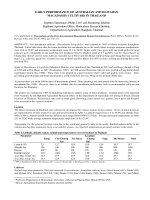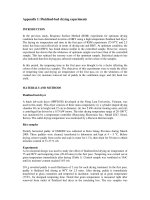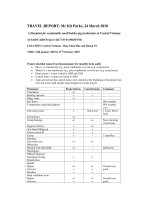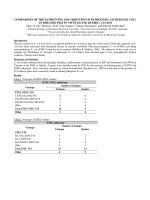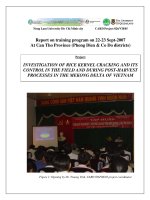Nghiên cứu khoa học nông nghiệp " A blueprint for sustainable small holder pig production in Central Vietnam " pdf
Bạn đang xem bản rút gọn của tài liệu. Xem và tải ngay bản đầy đủ của tài liệu tại đây (41.85 KB, 8 trang )
TRAVEL REPORT: Dr Colin Cargill
CENTRAL VIETNAM – 8
th
to 23
rd
November 2007
CARD Project (424 7155 01 004/05VIE)
A blueprint for sustainable small holder pig production in Central Vietnam
Participating Agencies:
Vietnam:
National Institution of Animal Husbandry (NIAH) – Dept of Small Livestock Research
Hue University of Agriculture and Forestry (HUAF) – Faculty of Animal Sciences
National Institute of Veterinary Research (NIVR) – Dept of Bacteriology
Department of Agricultural and Rural Development of Quang Tri Province
Vietnamese farmer Association – Thua Thien Hue
Australia:
The University of Queensland – School of Veterinary Science
South Australian Research and Development Institute (SARDI)
Department of Primary Industries Victoria – Pig Health and Research Unit
Report Date – May 2008
OBJECTIVES
1. To travel to Ho Chi Minh City:
a. To meet with Dr Tony Fahy and Mr Patrick Daniel
b. To visit Dr Dong Manh Hoa, Director Regional Animal Health Office No.6
2. To travel to Hue Vietnam:
a. to review progress of project;
b. to meet with Professor Linh and his team to discuss housing and farrowing pen design
models and review progress on farm survey;
c. to visit farms in two provinces in Central Vietnam – Quang Tri and Thua Thien Hue;
d. to assist in the training of Commune Extension Veterinarians in doing farm audits and
assessments;
3. To travel Ha Noi:
a. to visit NIVR to meet with Dr Phu and Mr Tuan along with Dr Tony Fahy
b. to visit Thuy Phuong Pig Research Unit to meet with staff and discuss research
opportunities;
c. to meet with Dr Coi (NIAH), Mr Bien (NIAH), Dr Phu (NIVR), Mr Tuan (NIAH),
Professor Linh (HUAFF), Dr Fahy and Mr Patrick Daniels to review progress and discuss
relevant issues relating to the project.
PRINCIPAL CONTACTS
Name Position Institution
Ho Chi Minh City
Dr Dong Manh Hoa Director Regional Animal Health Office
No.6
Hue
Professor Nguyen Quang Linh Dean – Faculty of Veterinary
Science
Hue University of Agriculture
and Forestry
Dr Hoang Duyet
Lecturer – Faculty of Animal
Science
Hue University of Agriculture
and Forestry
Ho Ngoc Phuong
Faculty of Animal Science Hue University of Agriculture
and Forestry
Mr Ngo Huu Toan
Lecturer – Faculty of Animal
Science
Hue University of Agriculture
and Forestry
Mr Dang Bien Department of Small Livestock
Research
National Institution of Animal
Husbandry
Mr Au Tuan
Department of Bacteriology National Institute of Veterinary
Research
Mr Anh Extension Officer Department Agriculture Quang
Tri Province
Mr Dao Van Hop Chairman Hai Lang Commune, Quang Tri
Province
Dr Nguyen Que Coi. Director – Thuy Phuong Pig
Research Centre
National Institute of Animal
Husbandry
Associate Professor Cu Huu
Phu
Head – Department of
Bacteriology
National Institute of Veterinary
Research
Mr Nguyen Huyen
Department of Bacteriology National Institute of Veterinary
Research
Mr Nguyen Ngoc Phuc Vice-Director – Thuy Phuong
Pig Research Centre
National Institute of Animal
Husbandry
TRAVEL SCHEDULE
DATE Location ACTIVITY
2
nd
November Adelaide to Singapore: depart 13:05 / arrive 17:40
See trip report to NTT Province Indonesia
8
th
November Singapore to Ho Chi Minh City: depart 14:45 / arrive 15:50
9
th
– 19
th
Nov HCMC
Visit to Regional Animal Health Office No.6
Meeting with catholic relief Services
11
th
November HCMC
HCMC to Hue: depart 15:00 / arrive 16:20
12
th
November Hue
Confined to hotel due to flooding
13
th
November Hue
Meetings with Professor Linh, Dr Duyet, Mr Toan, and Mr
Phuong Re: schedule for visits to Hue and Quang Tri
14
th
November Hue
Farm visits – Hue Province
15
th
– 16
th
Nov
Hue Farm visits in Quang Tri Province
17
th
November Hue
Farm visits Hue Province
18
th
November
Hue Visit to fresh food markets
Free
19
th
November Hue Visit to sectors of the market chain and slaughter houses
20
th
November Hue
Hue to Ha Noi: depart 12:10 / arrive 13:20
21
st
November Ha Noi Meeting at NIVR with project leaders
22
nd
November
Ha Noi Visit to Thuy Phuong Pig Research Centre
Visit to National Centre for Veterinary Diagnosis
23
rd
November Ha Noi Meeting with World Vision re Indonesian Projects
24
th
– 25
th
Nov Ha Noi Free
26
th
Nov Ha Noi Meetings with CIP Farmer Training Program Co-ordinators
27
th
November Ha Noi Ha Noi to Singapore: depart 13:30 / arrive 18:00
Singapore to Adelaide: depart 23:50
28
th
November
Adelaide Arrive Adelaide 09:05
EXECUTIVE SUMMARY
PROJECT ACTIVITIES AND REVIEW OF PROGRESS
The major aim of the visit was to review progress and to assist in the training of a core group of
extension veterinarians and technicians in assessing and auditing piggeries for management
(husbandry, nutrition, health) and housing (ventilation, temperature control, waste management).
Unfortunately only 2 to 3 extension veterinarians and technicians were available for training in
each commune or village, and the concept of training and mentoring of local extension services
appeared to be lost in translation. This may have been due to a misunderstanding about the
purpose of the training, or a cultural difference in the approach to training. The training and farm
visits were also interrupted by flooding and 2 days were lost at the beginning of the trip when we
were confined to our hotel.
During our visit to Thua Thien Hue Province I visited 10 project or demonstration farms over 2
days (14
th
and 17
th
November). Herd size ranged from 3 to 9 sows and the majority of farms had
erected dry sow stalls. Twenty farms had received creep boxes and although farmers like the
creep boxes, only one has built his own extra box. The cost of each box was between 400,000 and
500,000 VND (AUD$ 28 to 30), which seemed rather expensive. Each project farm has also
received 5 to 6 Mon Chai gilts, many of which are either pregnant or have farrowed. The HUAFF
Team originally recruited 27 farms, but 3 have dropped out since the project commenced.
In Quang Tri Province, where the NIAH Team has recruited 30 farms, I visited 9 farms over 2
days (15
th
and 16
th
November). None of the farms have been supplied with creep boxes and only a
few have built dry sow stalls. No gilts have been supplied as yet, due to an outbreak of FMD, but
Mr Bien has undertaken to have the demonstration farms in Quang Tri Province ready by January
2008.
A query was raised about a line in the project budget for the supply of gilts, but on checking the
budget no line was noted. No effort is being made to supply farrowing crates as these are
generally too expensive. The cost of imported crates ranges from around 3 million VND (AUD$
214) from China to around 7 million VND (AUD$ 500) from Europe. However, a local
manufacturer could be able to build a model at more reasonable cost.
The major problems identified in piggeries in both provinces included:
1. Ventilation – In many sheds there was a lack of adequate ventilation, even in well
designed sheds with optimal side wall openings. Farmers cover the openings with plastic
bags and are reluctant to remove them, even when it is warm and not raining. Part of the
problem is that it is time consuming to open them. Hence a demonstration on how to
make a roll down/roll up blind out of the plastic bags would be useful. In one farm visited
in Thua Thien Hue Province, the value of a ridge vent was demonstrated with the aid of
Mr Tuan’s cigarette smoke. Even with the side wall openings closed, the smoke was
eliminated from the shed through the ridge vent. In the section with no ridge vent it just
hung in the air space above the pens. Increasing the length of eaves to protect pigs from
direct sun in fine weather and rain in wet weather would also pay dividends.
2. Creep Boxes – Although the creep boxes are popular and on most farms visited the
majority of piglets were sleeping inside the box. While the heating bulbs were probably
too weak, in my opinion, and based on experience from Papua where villages do not have
electricity, a heating lamp is probably not needed after about the 3
rd
or 4
th
day post-
farrowing. Cold piglets were often observed on farms where no creep box was available
and although heat lamps were provided these were often placed above the height of the
pen walls, allowing the heat to be dissipated across the shed and not onto the piglets.
Hence it appears that the majority of farmers do not fully understand the dynamics of
using a heat lamp for the piglets or how it operates. One farmer used straw nests made of
dry grass for piglets but even here piglets with access to a creep box appeared warmer.
3. Dry sow stalls – Stalls had been constructed on most farms in Thua Thien Hue Province
but not in Quang Tri.
4. Nutrition and feeding – Restrict feeding is a common practice on most farms but although
diets appear inadequate, sow condition scores ranged from 2.5 to 3.5. Only a few
individual sows with body condition scores of 1.5 and 2 were observed. Diets fed to pigs
ranged from commercial diets, home mixes based on locally available crops and various
combinations. In general fatteners were fed commercial diets with protein levels around
15 to 17% but sows were generally fed a diet consisting of locally available crops and
ingredients mixed with a commercial diet. Ingredients used in diets included rice, rice
bran, maize, cassava meal, ensilaged fish, banana trunks and sweet potatoes. A typical
example of a diet was:
a. rice – 0.7kg; rice bran – 1 kg; maize – 1kg; sweet potatoes – 3kg; commercial
feed – 0.5kg. Some times commercial feed was replaced with fish or ensilaged
fish.
b. Cost of ingredients were quoted in VND/kg at: rice – 4,000; rice bran –
3,000;cassava meal – 2,000; maize – 4,000; fish – 10,000; and ensilaged fish –
6,000.
c. Although sows were only fed 2.5kg/day, the condition scores for all sows on the
farm were above 2.5.
d. On another farm where fatteners were fed a commercial diet, growing pigs were
fed 0.5 to 0.9 kg/day from weaning to 30kg lw; 0.9 to 1.5 kg/day from 31 to 60
kg lw; and 1.5 to 2.2 kg/day from 61 to 100kg lw.
5. Water – The majority of farms failed to provide water on a continuous basis, even for
lactating sows and this needs urgent attention and promotion.
6. Records – Sow records were observed on some of the farms visited in Thua Thien Hue
Province, but none of the farms in Quang Tru Province. It would help in the evaluation of
the project if sow and litter records were kept on all farms and if a few farms in each
Province were selected for more detailed recording. Litter sizes on the farms visited
ranged from 2 to 15 but it was not always possible to obtain data on “born alives” verses
total born and number weaned. It would also be helpful to have validation of the number
of litters farrowed/sow/year, as most farmers used AI for mating sows and many did not
have boars. We have increased productivity significantly in Indonesia by providing boar
stations in villages so that sows have contact with a boar immediately after weaning.
Whether this strategy would help with Mon Chai is unknown.
7. Weaning – Weaning age varied between the 2 Provinces. In Thua Thien Hue Province
pigs tend to be weaned at around 45 days and sold at around 60 days at 10 – 12 kg
liveweight and sold at 30,000 VND/kg. If grown out to 90 to 100kg the price falls to
17,000 VND/kg. in Quang Tri Province the majority of piglets were weaned at around 35
days (6 kg) and exported to China.
8. Vaccination and medication – Many farmers visited did not appear to know about
vaccination or the availability of vaccines or the appropriate use of medicines. In the one
medicine shop visited in Quang Tri little information was available on appropriate
medication for pigs and no vaccines were available. Dr Tony Fahy has offered to provide
an updated medication, and treatment list as well as a vaccination schedule for farms to
follow. This will prove extremely valuable in achieving improved pig health on farm.
9. Piggery buildings attached the family home – A major problem identified is the “lean-to”
or “skillion” piggery attached to the family home. These structures raise issues of hygiene
and human health risks, as well as odour and waste management problems. I would like
to see some discussion regarding our attitude to continued support for these farms. Two
farms visited in Quang Tri Province had built new stand alone sheds for the pigs since I
visited in April 2007, and this is obviously the preferred solution. My opinion is that
where possible we should try to renovate the buildings in the short term to enable the
farmer to obtain the capital to build a new stand alone piggery. If it is not possible to
adequately renovate the building, we should withdraw support for the farmer. Dr Duyet
has achieved reasonable success with 2 farms we visited in his area where the back wall
of the pig house has been opened up providing improved ventilation and giving pigs
access to a dunging area outside of the building. This has effectively improved hygiene
and ventilation and reduced odour within the family home. It has also moved the dunging
area away form the family cooking area. Another good example of a well renovated
piggery attached to the family home was observed in Quang Tri Province.
Pig Market chain
As far as I understand the marketing process, buyers collect pigs from the farm as required and as
available and supply them to “the middle man” who slaughter the pigs and sell the carcases as
fresh pork to stall owners at the fresh food market or to processors. The “middle man” we visited,
who was a woman, has up to 12 buyers who collect 200 to 300 pigs each day for slaughter. The
majority of pigs are exotics, collected mainly from Binh Dinh Province with a smaller percentage
crossbreds (F1’s) purchased around Hue. Pure Mon Chai tend to be used only for breeding F1’s.
The current price for crossbreds is 22,000 VND / kg liveweight and 14,000 VND / kg for exotics.
The price for dressed pigs is 35,000 VND/kg for exotics (dressing percentage 75%) and 32,000
VND/kg for crossbreds (dressing percentage 65 to 68%). The large head on crossbreds reduces
dressing percentage and pigs are usually sold at around 65 to 70 kg liveweight. Pork from exotics
sells faster than F1’s and prices will increase as the Tet holiday approaches. The increased
availability of sea food in summer reduces the price of pork. Currently the price of pork in the
fresh food market is around 55,000 VND.
Hence the value of a live crossbred pig is approximately 1.5 million VND (AUD$ 106.00) and a
live exotic (sold at around 90kg lw) is 2.2 million VND (AUD$ 157.00).
MEETING WITH CARD PROJECT TEAM AT NIVR – HA NOI
Those attending: Dr Phu and Mr Toan (NIVR), Dr Qoi and Mr Bien (NIAH), Prof Linh
(HUAFF), Dr Tony Fahy and Mr Patrick Daniels (PHRU – DPI Victoria) and Dr Colin Cargill
(SARDI).
Following discussion and a review of progress in each Province NIAH have undertaken to have
their demonstration farms supplied with creep boxes and gilts by the end of January 2008. While
this is well behind scheduled it should still enable the project to be completed on time.
It was generally agreed that we need to provide farmers with more information about medication
and vaccination and the use of creep boxes and managing ventilation. Some farmers will also
need advice on renovation and even designs for new free-standing pig sheds.
It was decided to develop a kit and provide one to each farm, as well as to extension veterinarians
and technicians. The kit should include:
• an explanation of why it is important to provide a warm constant temperature for pigs
pre-and post-weaning, and why it is important to provide a cooler temperature for sows;
• an explanation for the use of creep boxes plus design, dimensions, construction
information, and cost;
• a copy of pig building plans developed by Dr Duyet and Mr Bien along with costs and
instructions;
• an explanation on why providing adequate ventilation is important and how to construct
and operate blinds that cover side wall openings and easily operated.
• A vaccination guide and list of vaccines available and suppliers;
• A treatment guide with medicines available and what to use for different clinical signs;
• A feeding guide (to be prepared by Mr Phuong) that would include how to provide a
balance diet at reduced cost by diluting commercial diets with locally grown crops – note
I will ask Dr Phil Glatz from SARDI who has successfully developed this strategy in
PNG and the Solomons to provide Mr Phuong with details);
We also need to ensure that the team from HUAFF have post-mortem kits and diagnostic kits
available when they visit farms. To achieve this it was suggested that Mr Toan (NIVR) should
take a supply of post-mortem and diagnostic kits to the HUAFF team and demonstrate how to use
them correctly while he is there. He should also visit Quang Tri with Mr Bien and repeat the
exercise.
It was also agreed that we should select 5 farms in each Province and increase the amount of data
collected through farmer records. However, this could be expanded to include all farms as this
would provide solid information to validate the value of the project. This could be included as
one of the activities undertaken during Tarni’s visit.
While I felt that there was general agreement to the proposals, some one will need to take the
running on each issue. I am happy to work with Dr Duyet and Mr Bien in preparing an
information sheet on rationale for using the creep boxes and improving ventilation, as well as an
information sheet about the importance of water supply. Dr Tony Fahy has already collected and
provided much of the information required for the medication and vaccination schedules and Mr
Tuan could complete this task under supervision from Dr Fahy and Dr Phu. The point was made
by Dr Fahy that although vaccines are available, most farmers, as well as the extension
veterinarians, were not aware of either the vaccines or how to use them. Similarly; they had little
knowledge of which medicine was appropriate for specific clinical signs and how to use them.
VISIT TO THUY PHUONG PIG RESEARCH UNIT
The major outcome from our visit to the Thuy Phuong Pig Research Unit was to seek funds for a
workshop in 2008, to which key people from across Vietnam who are involved in pig production
as health advisers, production consultants, nutritionists, extension consultants and marketing
operatives could be invited. Dr Fahy has agreed to speak on managing health and the diagnosis
and treatment of common diseases and I volunteered to give a talk on housing, husbandry and pig
flow management. This would provide a great opportunity for laying the foundations for a
National Pig Society and provide a good venue for extending the project outcomes stated above
to the Vietnamese Pig Industry. Possibilities for funding include CARD and Crawford Fund.
VISIT TO REGIONAL ANIMAL HEALTH OFFICE No.6
The visit to the Regional Animal Health Office (No.6) in Ho Chi Minh City was to gain an
understanding about the official animal health services in Vietnam in an attempt to find
connections between the project and the farming community we wish to influence. Nationally
Vietnam is divided into 7 Regional Animal Health Districts and Hue is situated in No.4. Each
Region is regarded as a sub-Department of Animal Health and is divided into Districts with an
Animal Health Centre in each District. Within the district there are a number of village animal
health teams. The latter are responsible for vaccination programs for major diseases such as CSF
and FMD, as well as disease control and eradication and public health. However, their role in day
to day health problems on the farm is limited as is their contact with small holder farmers.

